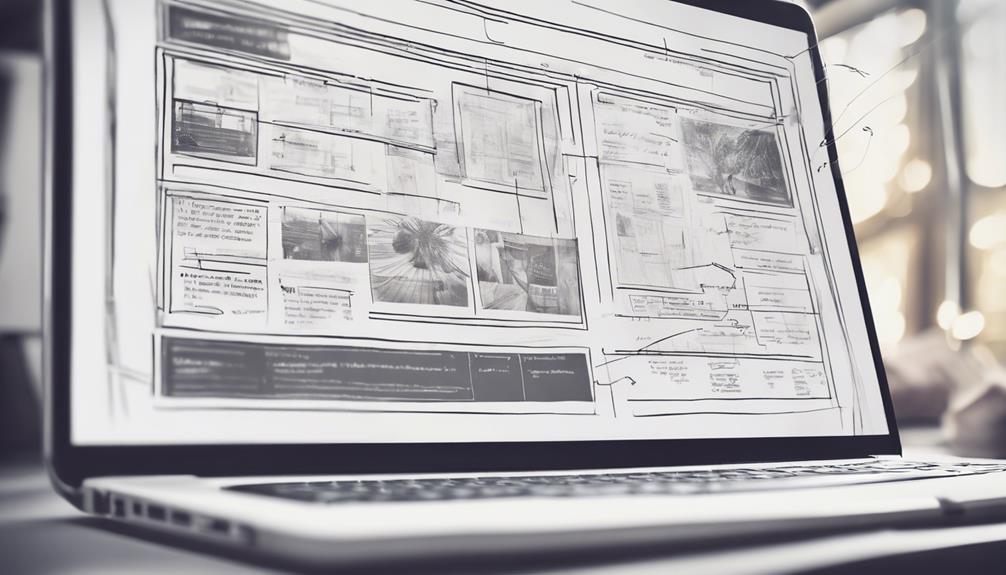In the realm of digital landscapes, the intricacies of web design and development are paramount. From understanding the core principles to meticulously planning the architecture, each step in the process holds significance.
But, what truly sets a project apart is the seamless integration of user-friendly interfaces and responsive design elements. As we navigate through the layers of this guide, uncovering the crucial tools and technologies along the way, the journey towards creating an impactful web presence begins to unfold.
Understanding Web Design Fundamentals

Exploring the foundational principles of web design is crucial for creating visually appealing and functional websites that effectively engage users. Learning web design involves understanding web design fundamentals that serve as the building blocks for creating successful online platforms. These fundamentals encompass various aspects, including layout, color theory, typography, and user experience.
One key aspect of web design fundamentals is layout. A well-thought-out layout ensures that content is organized in a clear and intuitive manner, making it easy for users to navigate the website. Understanding the principles of visual hierarchy and how to structure content helps designers create websites that are visually engaging and user-friendly.
Color theory is another important element of web design. Colors can evoke different emotions and influence how users perceive a website. Designers need to have a good grasp of color combinations, contrasts, and the psychology behind different hues to create visually appealing and harmonious designs that resonate with the target audience.
Incorporating appropriate typography is also essential in web design. Choosing the right fonts and text styles not only enhances the website's aesthetics but also improves readability and user experience. By mastering these web design fundamentals, designers can create websites that are not only visually captivating but also highly functional and user-centric.
Planning Your Website Structure
Understanding the foundational principles of web design is essential for creating visually appealing and functional websites; now, focusing on 'Planning Your Website Structure' is pivotal in establishing a solid foundation for a successful online platform. When it comes to web design and development, the structure of a website plays a crucial role in ensuring a seamless user experience. Web design companies often start by outlining the site's navigation, information architecture, and overall layout to cater to the target audience's needs effectively.
During the planning phase, web design companies need to consider factors such as the site's purpose, the target demographic, and the desired user journey. By creating a clear website structure, users can easily navigate through the site, find relevant information, and engage with the content efficiently. Implementing a well-thought-out structure also helps with search engine optimization (SEO) efforts, making the site more discoverable to potential visitors.
Choosing the Right Tools and Technologies

To craft a cutting-edge website, selecting the appropriate tools and technologies is paramount in ensuring optimal performance and user satisfaction. When it comes to web design, using the right web design tools, web design programs, and web design software can make a significant difference in the quality of the final product. There is a wide range of tools available to assist designers in creating visually appealing and functional websites. Popular web design programs like Adobe Dreamweaver, Sketch, and Figma offer powerful features for designing and prototyping websites. Additionally, content management systems (CMS) such as WordPress and Joomla provide efficient ways to manage website content.
Choosing the right tools and technologies also involves considering factors such as scalability, ease of use, and compatibility with different devices and browsers. It is essential to stay updated with the latest trends in web design tools and technologies to deliver modern and user-friendly websites that meet the evolving needs of online users.
Designing User-Friendly Interfaces
Crafting intuitive and user-centric interfaces is essential in web design to enhance user experience and promote engagement with the website. When focusing on UI web design, adhering to key web design principles is crucial. By prioritizing usability, simplicity, consistency, and visual hierarchy, designers can create interfaces that are easy to navigate and visually appealing. Incorporating UX web design elements such as clear navigation menus, intuitive forms, and interactive elements can further enhance the overall user experience.
To ensure a user-friendly interface, designers should conduct thorough research to understand the target audience's needs and preferences. Implementing user testing and gathering feedback can help identify areas for improvement and refine the interface accordingly. Additionally, optimizing loading times, ensuring mobile responsiveness, and maintaining accessibility standards are essential for a seamless user experience across different devices.
Implementing Responsive Web Development

When developing a website, ensuring responsiveness across various devices is crucial for optimal user experience and accessibility. Responsive web design is a key aspect of modern web design development. Implementing web design that is responsive involves creating a website that can adapt and display correctly on different screen sizes, including desktops, laptops, tablets, and smartphones.
To achieve responsive web development, designers and developers utilize techniques such as fluid grids, flexible images, and media queries. Fluid grids enable the content to adapt to the screen size, ensuring that the layout remains consistent and user-friendly. Flexible images scale accordingly to prevent distortion or cropping on various devices. Media queries allow the website to apply different styles based on the device's characteristics, such as screen resolution and size.
Testing and Launching Your Website
Ensuring thorough testing and a successful launch are critical steps in the website development process. Before launching your website, it is imperative to conduct comprehensive testing to ensure functionality across various browsers and devices. Testing should encompass checking for broken links, responsiveness, load times, and overall user experience. This phase is crucial for identifying and rectifying any issues that may hinder the website's performance.
Launching a website involves making it live to the public. It is essential to have a well-thought-out plan for the launch to generate maximum impact. This includes considering marketing strategies, SEO optimization, and social media integration to drive traffic to the site. Collaborating with a web design agency can streamline the launch process and ensure a successful debut.
Staying updated on current web design trends is also crucial for a successful launch. Implementing the latest design elements and features can enhance the website's appeal and functionality, ultimately leading to a more engaging user experience. By prioritizing testing and a well-planned launch, you set the stage for a successful website that resonates with your target audience.
Frequently Asked Questions
How Can I Optimize My Website for Search Engines Like Google?
To optimize your website for search engines like Google, focus on creating high-quality, relevant content, using appropriate keywords, optimizing meta tags, improving website speed, obtaining backlinks from reputable sources, and ensuring mobile responsiveness for better user experience and search engine rankings.
What Are Some Common Security Measures I Should Implement on My Website?
Implementing common security measures on a website is crucial to safeguard data and protect against cyber threats. Strong passwords, regular software updates, SSL certificates, firewall protection, and routine security audits are recommended practices to enhance website security.
How Can I Integrate Social Media Features Into My Website?
Integrating social media features into a website involves strategically placing share buttons, embedding social media feeds, and enabling login options via popular platforms. This enhances user engagement, expands reach, and fosters a sense of community among visitors.
What Are Some Best Practices for Website Accessibility for Users With Disabilities?
When considering website accessibility for users with disabilities, best practices include ensuring compatibility with screen readers, providing alternative text for images, designing for keyboard navigation, and testing with assistive technologies to guarantee a user-friendly experience for all.
How Can I Monitor and Analyze the Performance of My Website After It Has Been Launched?
After launching your website, performance monitoring and analysis are crucial. Utilize tools like Google Analytics to track visitor behavior, page load times, and conversion rates. Regularly assess data to make informed decisions for optimizing user experience and achieving business goals.










